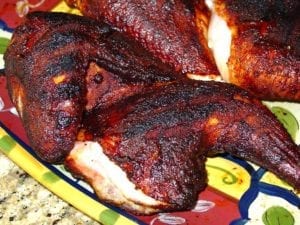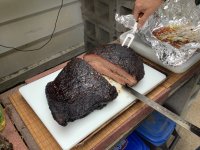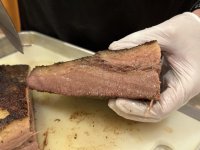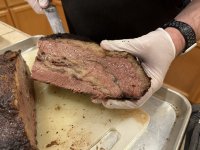-
Enter the TVWB 27th Anniversary Prize Drawing for a chance to win a Weber Traveler Portable Gas Grill! Click here to enter!
You are using an out of date browser. It may not display this or other websites correctly.
You should upgrade or use an alternative browser.
You should upgrade or use an alternative browser.
Does most of the heat come from the bottom? Or reflect off the top of the dome?
- Thread starter Mike_S
- Start date
Brett-EDH
TVWBB Olympian
Fat cap up on a WSM cook and you need the water bowl inside to deflect the heat so it rises up the sides of the WSM and then convects down from the domed lid. I’d recco you place a chunk of wood under the brisket so as to dome the brisket and any fat will drip off and not pool on your brisket and then ruin your bark.
I’d only do a very light trim up precook and cut the thin tail of the flat off and save it for burger meat as the thinnest part of the flat will burn and overcook. This way your flat is even in thickness and will temp upwards evenly.
I’d only do a very light trim up precook and cut the thin tail of the flat off and save it for burger meat as the thinnest part of the flat will burn and overcook. This way your flat is even in thickness and will temp upwards evenly.
Timothy F. Lewis
TVWBB 1-Star Olympian
ChuckO
TVWBB 1-Star Olympian
I am smoking a brisket this weekend and I want the fat cap to act as an insulator against the heat. T-Roy cooks on Youtube claims the heat actually comes from the top of the dome onto the meat. Is that true? Or does most of the meat come from the bottom?
Hi Mike, I'm not sure that the fat cap is correctly considered to be an insulator against heat. It sounds like this might be your first brisket cook? I suggest checking out: https://www.virtualweberbullet.com/whole-brisket-central-texas-style-butcher-paper/
I copy and pasted the specifics regarding fat side up or down. As you can see below, Chris starts with the fat side down until an internal temp of 170 degrees. It is then wrapped and cooked fat side up until done. My point to pointing this out is that your question is about "insulation" and about having the fat side up as protection from heat. The wrapping of the meat at 170 does insulate the meat from drying out, to a degree. There are other methods, but this (link above) is a tried and true method, especially for first time.
- Remove any fat and silverskin from the lean side, trim the fat side down to 1/4″ thick. Make the brisket “aerodynamic” per Franklin’s videos.
- Apply a 50/50 kosher salt and coarse ground pepper rub 1 hour before cooking.
- Cook the brisket fat-side down at 250-275°F to an internal temperature of 170°F.
- Wrap in butcher paper and continue cooking fat-side up until 205°F and probe tender.
- Rest in paper for 10 minutes on kitchen counter, then move into an empty cooler and rest for 2-3 hours before slicing.

Cooking Topics - The Virtual Weber Bullet
Articles and recipes explaining how to cook barbecue on the Weber Smokey Mountain Cooker, plus a variety of reference topics and instructional videos.
Darryl - swazies
TVWBB Diamond Member
I agree, I go fat side down on every low and slow cook........besides beef ribs.
Timothy F. Lewis
TVWBB 1-Star Olympian
I‘ll try it next time, if I remember!
Mike_S
TVWBB Member
First on the WSM, not overall. Thanks for your response!It sounds like this might be your first brisket cook?
Darryl - swazies
TVWBB Diamond Member
Fat side up on the WSK. I don’t understand why you’d do fat side down.
This is one of those debates that goes back and forth with no proven correct outcome........I think anyways. I don't cook brisket often and with pork butt I don't want all that fat at the end anyways so I look for the most bark I can get and I am not going to let a bunch of fat get in the way of that.
Brett-EDH
TVWBB Olympian
so trim the fat off the butt. that'll get you max bark.This is one of those debates that goes back and forth with no proven correct outcome........I think anyways. I don't cook brisket often and with pork butt I don't want all that fat at the end anyways so I look for the most bark I can get and I am not going to let a bunch of fat get in the way of that.
from my experience, heavily trimming briskets and now barely trimming briskets, the barely trimmed ones are more juicy and flavorful, cooked fat cap up. i'm sure this debate will go on after this post. do what works best for you. it's your $60 piece of meat.
Jim C in Denver
TVWBB Wizard
so trim the fat off the butt. that'll get you max bark.
and also butterfly the butt to expose more barky surface area. cooks faster too.
and also butterfly the butt to expose more barky surface area. cooks faster too.
Darryl - swazies
TVWBB Diamond Member
I have been cutting my shoulder into usually 3 pieces now with a 7+ pound shoulder.so trim the fat off the butt. that'll get you max bark.
and also butterfly the butt to expose more barky surface area. cooks faster too.
After watching Michael Richards do this I gave it a shot and nothing but positives..
Way more rub surface area.........cooks way faster......tons of bark, everyone goes for it once pulled in the pan anyways.
I usually end up braising from 165 until the end after the bark is sufficient. Getting that 190 degrees and holding there as long as possible before hitting 200 + degrees is the deal maker.......fabulous.
60 bucks!!!! lol, don't you know that like $400 in CAD.......so trim the fat off the butt. that'll get you max bark.
from my experience, heavily trimming briskets and now barely trimming briskets, the barely trimmed ones are more juicy and flavorful, cooked fat cap up. i'm sure this debate will go on after this post. do what works best for you. it's your $60 piece of meat.
Seen some non trimmed packers on the weekend and they were 90 bones and up......you know trimmings is like 4 pounds or something....
Went to another butcher and the price was way better and all trimmed up, maybe a bit to clean though.
Brett-EDH
TVWBB Olympian
don't buy the trimmed. get a whole primal cut, untouched. on a 16#, you can trim down 1-2# fat max and you'll be perfect and ready to go. render that fat to tallow and use it, or make french fries in it. no waste here. i'm assuming pricing is $3.99 or $3.49 USD per #. you're on your own for kg conversions.I have been cutting my shoulder into usually 3 pieces now with a 7+ pound shoulder.
After watching Michael Richards do this I gave it a shot and nothing but positives..
Way more rub surface area.........cooks way faster......tons of bark, everyone goes for it once pulled in the pan anyways.
I usually end up braising from 165 until the end after the bark is sufficient. Getting that 190 degrees and holding there as long as possible before hitting 200 + degrees is the deal maker.......fabulous.
60 bucks!!!! lol, don't you know that like $400 in CAD.......
Seen some non trimmed packers on the weekend and they were 90 bones and up......you know trimmings is like 4 pounds or something....
Went to another butcher and the price was way better and all trimmed up, maybe a bit to clean though.
Timothy F. Lewis
TVWBB 1-Star Olympian
My wife does not like it when I butterfly my butt! The bark she sees (well…) has no interest in!so trim the fat off the butt. that'll get you max bark.
and also butterfly the butt to expose more barky surface area. cooks faster too.
Dustin Dorsey
TVWBB Hall of Fame
It might be different if you run with water in the pan, I suspect that T-Roy did. I usually don't. It's definitely more heat coming from the bottom with no water. When I went fat up, the bottom would get really dry and be hard to slice through. I started going fat down until the wrap and then fat up after the wrap because I use paper. When I went fat down during the wrap phase the rendered fat would stick to the paper. Also the paper will protect the bottom as there's usually more paper under there.
So I guess it depends on whether you run water or not. If you don't, fat down. If you do, fat up.
Properly rendered fat is delicious so in addition to protecting the meat, you also want more heat on the fat to render it properly. Hopefully all that makes sense.
So I guess it depends on whether you run water or not. If you don't, fat down. If you do, fat up.
Properly rendered fat is delicious so in addition to protecting the meat, you also want more heat on the fat to render it properly. Hopefully all that makes sense.
Brett-EDH
TVWBB Olympian
your pic has me all excited to smoke one in September for Rosh Hashanah (Jewish New Year). this just looks so good. and that 40" slicing knife!! yowza!!!I have always done mine fat cap down, that method has served me very well.
View attachment 72682
this was last weekend 19# mammoth! 20 hours cook time, one 30 briquette recharge at 15 hours in.
Not sure it matters much if you're using water in the pan, I've done it both ways for years and both work with water in the pan. If using an empty pan, I think fat side down is advantageous. So I've ended up cooking all my briskets fat side down in all instances.



